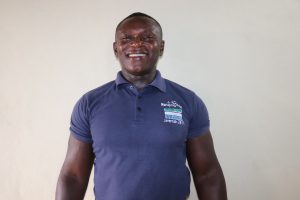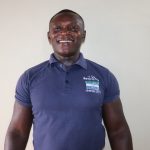July, 2022: Benkia Community Well Rehabilitation Complete!
We are excited to share that a safe, reliable water point at Benkia Community in Sierra Leone is now providing clean water to community members! We also conducted hygiene and sanitation training, which focused on healthy practices such as handwashing and using latrines.
"One of my tasks is to fetch water for my parents every day," said 14-year-old Aruna.

Aruna pours out a cup of water while community members celebrate.
"In the morning, I would rush to the stream to fetch water [before] the pump well was locked because of [the] water shortage. Going to the stream to fetch water was not an easy task because the distance is far and the way is bushy. When the water from the stream was dirty, I could not fetch drinking water and I would return to the house to wait until it is clean before I could go to fetch water.
"I used to be worried about when I would finish fetching water from the stream because I knew it was not easy. I am happy now because the pump well is working well, and I am getting enough water from it. There will be enough water to drink, cook and wash."
Adults were just as excited for the new water point.

Ramatu collects water from rehabilitated well.
35-year-old trader, Ramatu Kamara, said: "Today, I am overly excited to see the pump providing clean water [during] this season of the year. It was never like this before. It used to get dry during the dry season, but I thank God it has enough water coming out at this moment.
"I used to fetch water from the stream when the pump well dried. The stream could not provide enough water that would serve everyone in this village. It was exceedingly difficult in the morning to fetch water from the stream because people rushed to get clean water. The stream water well is not covered and therefore, any animal or dirt could get access to it and contaminate the water.

"I drank the water because it was the only source of water to drink when the pump was dried. I know that drinking impure water will cause me to fall sick, but I had no choice. I am incredibly happy because I will not drink [from] the stream and I know that I am safe from getting sick from impure water. The pump is just a few steps away [from] my house so I can just spend a few [minutes] to fetch water from the pump. I will have enough time to trade and complete other duties.
"I am incredibly happy today because I now have access to enough water to do everything that I need water to complete. I can also get clean water to drink from this pump well."
We held a dedication ceremony to officially hand over the well to the community members. Several local dignitaries attended the ceremony, including representatives from the Ministry of Water Resources, the Ward Council, and the Port Loko District Council.

Osman Fofanah from the Ministry of Water Resources bangs a drum while community members celebrate.
Each official gave a short speech thanking everyone who contributed to the rehabilitation of the water project and reminding everyone to take good care of it. Then, Aruna and Ramatu made statements on their community's behalf. The ceremony concluded with celebration, singing, and dancing.
Clean Water Restored
The drill team arrived the day before beginning work. They set up camp and unpacked all their tools and supplies to prepare for drilling the next day. The community provided space for the team to store their belongings and meals for the duration of their stay. The following day, the work began.
First, we raised the tripod, the structure we use to hold and maneuver each drilling tool. Next, we measured the well's original depth. We then socketed the pipes and installed a casing.

Finally, we lined up the drill rods and started to drill! We reached a final depth of 14 meters with water at 6 meters. The hand-drill method allowed the team to install the cylinder far below the aquifer so that the community has excellent water access throughout the year.
With drilling complete, we installed screening and a filter pack to keep out debris when the water is pumped. We then cemented an iron rod to the well lining and fixed it with an iron collar at the top.

Bailing underway.
Next, we bailed the well by hand for three days and flushed it, clearing any debris generated by the drilling process. Finally, we tested the yield to ensure the well would provide clean water with minimal effort at the pump.
As the project neared completion, we built a new cement platform, walls, and drainage system around the well to seal it off from surface-level contaminants. The drainage system helps to redirect runoff and spilled water to help avoid standing water at the well, which can be uncomfortable and unhygienic and a breeding ground for disease-carrying mosquitoes.

At last, we installed the pump and conducted a water quality test. The test results showed that this was clean water fit for drinking!
New Knowledge
Before conducting any hygiene training, we called and visited the local water user committee to understand the community’s challenges and lack of sanitation facilities. We shared the findings from our discussions with the committee members to help them make the necessary adjustments before the training began. For example, we identified households without handwashing stations or ones that may need to repair their latrines. With this information, community members worked together to improve hygiene and sanitation at home.
After this preparatory period, we scheduled a time when members from each household using the water point could attend a three-day hygiene and sanitation training. We then dispatched our teams to the agreed-upon location to hold the meeting.

Training topics covered included handwashing and tippy taps, good and bad hygiene habits, disease transmission and prevention, COVID-19, worms and parasites, dental hygiene, proper care of the well's pump, keeping the water clean, the cost recovery system, dish racks and clotheslines, the importance of toilets, keeping latrines clean, balanced diets, the diarrhea doll, and HIV and AIDS.
One of the most interesting topics was dental hygiene, during which one of the community's elders, Pa Alimamy Kamara, stood and spoke to his peers, entreating them to listen to the advice of the training facilitators and brush their teeth every day. He said that if he'd received this knowledge in his younger years, perhaps he wouldn't have red and brown teeth and painful gums.

A community member demonstrates proper tooth brushing technique.
When we introduced the topic of malaria and mosquito nets, the community members all looked guilty. One woman explained that everyone in the village was guilty of misusing their mosquito nets by covering gardens and sheltering their domestic animals underneath them rather than sleeping within them as is intended. However, no one in attendance had heard that malaria is caused by an infected mosquito bite. The woman encouraged her fellows to keep their environments free from stagnant water and to use mosquito nets for their intended purpose of preventing malaria in the future.
"I can now identify the bad practices we were doing ignorantly," said 38-year-old Mabinty Kanu.

Mabinty Kanu.
"I have decided to make an improvement on these areas for a healthy living. I remember when I was a little girl, back in the days living in this remote village setting. I was always carried to a native doctor whenever I complained about my health. The only cure we knew was traditional herbs instead of going to the hospital.
"But my full participation in this training has really helped me understand that I should always practice good hygiene to stay well and strong and, when I or the children are sick, it is the hospital we should use. Therefore, I am pleading with every one of us to take this message home and make sure to share it so that we all can help educate the [others] on all that we have learned."
Conclusion
This project required a substantial collaboration between our staff, our in-country teams, and the community members themselves. When an issue arises concerning the well, community members are equipped with the necessary skills to rectify the problem and ensure the water point works appropriately. However, if the issue is beyond their capabilities, they can contact their local field officers to assist them.
Also, we will continue to offer them unmatchable support as a part of our monitoring and maintenance program. We walk with each community, problem-solving together when they face challenges with functionality, seasonality, or water quality. Together, all these components help us strive for enduring access to reliable, clean, and safe water for this community.
With your contribution, one more piece has been added to a large puzzle of water projects. In our target areas, we’re working toward complete coverage of reliable, maintained water sources within a 30-minute round trip for each community, household, school, and health center. With this in mind, search through our upcoming projects to see which community you can help next!
Thank you for making all of this possible!




 Borehole Well and Hand Pump
Borehole Well and Hand Pump
































